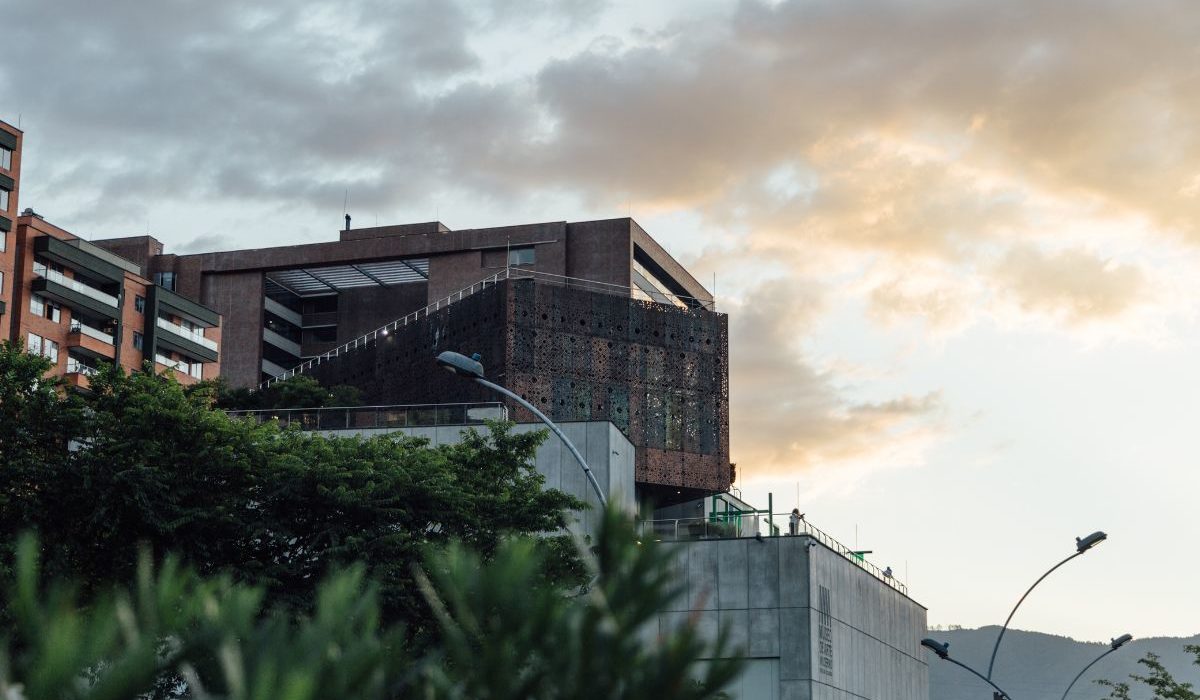About Us

MAMM is a space that questions traditions through a proactive attitude towards the determining issues of contemporary society. We make available to the audiences diverse ways of seeing and interpreting the world, providing meaningful experiences around art.
More than a physical space, we are a place where heritage, art production, the public and the institution come together; our exhibition program presents contemporary artistic and cultural production without thematic restrictions, in direct relation to our contexts: the city, the country, the continent.
We work to be a global and at the same time a local Museum, which promotes encounter, work, production and research among multiple ways of contemporary creation and enhances the development of subjectivities. These dimensions are mixed and nurtured to be exposed and disseminated to society through various exhibitions each year.
Over the last thirty years, Juan Fernando Herrán has developed his artistic practice through extensive fieldwork, frequently accompanied by a camera and his notebooks. Additionally, he has anchored his work in historical, sociological, and anthropological research. The transformation of materials, as well as the construction of images and structures, are rooted in the practices of other human beings in their quest for practical solutions and symbolic meaning.
Juan Fernando Herrán. Materialities and Constellations, a retrospective exhibition, showcases a selection of works from the late 1990s to the present, including earlier pieces that share illuminating plastic and thematic interests. A significant number of the works were conceived and elaborated during the artist’s prolonged stays in Medellín, initially following an invitation to participate in MDE11 (Encuentro Internacional de Medellín), which brought him closer to the city’s social and urban complexity. This exhibition also presents sketches, photographic records, drawings, and models that allude to the various stages of the artistic process, which culminate in photographs, sculptures, and videos. Despite their completion, these works possess a non-finite character as they remain in an intermediate and inconclusive state between the initial reference and the final work. Each of the works suggests questions that reveal human, socio-political, and economic conditions and needs, as well as spiritual and existential realities.
A notable outcome of these processes is the creation of works related to each other based on shared motivations, themes, or interests; creation which sometimes occurs in a concurrent, successive, or convergent manner. These works allow for the configuration of «constellations» that illuminate the intricate layers of the realities explored by the artist and unveil the diverse material and conceptual perspectives employed
The works and constellations in the different galleries are interconnected by three axes. Firstly, the concept of power is approached by Herrán in a range of expressions encompassing the power of social and political domination, the constructive power of human beings in their daily lives, and the deconstructive power with a spirit of discovery and criticism on the part of the artist. Secondly, historical processes are unfolded by bringing to light sedimented layers of the past to illuminate present situations and glimpse possible futures. Thirdly, the axis of social and cultural practices in which the life-death drive is confronted. In these works the capacity of matter and structures to communicate both survival strategies and the construction of imaginaries and meanings is made evident.
By engaging with the artworks, the audience can recreate images that communicate the referents and their practical aspects, social conditioning, and symbolic and existential dimensions in an illuminating and convergent way.
Juan Fernando Herrán. Materialities and Constellations emerges from a collaborative effort between Banco de la República and MAMM. In Medellín, the project includes an exhibition at MAMM and an intervention in the public space of a version of the work Héroes mil in the Centro Cultural del Banco de la República, located on Colombia Avenue in the city center. Following its presentation in Medellín, the exhibition will be hosted by the Museo de Arte Miguel Urrutia in Bogotá in September 2025.
Digital technologies cut across all areas of cultural production, transforming the structures inherited from modernity that continue to underpin our societies. Summoning the Ghosts of Modernity examines the implications of these technologies on creation, memory, and representation, and probing their limits through perspectives such as post-modernity, non-modernity and extra-modernity.
Emerging in the late 18th century as both a historical period and a cultural-intellectual paradigm, modernity established a series of meta-narratives centered on scientific and technological progress, the triumph of reason, and economic development as driving forces of globalized societies. At the same time, its consolidation intensified social inequalities, cultural alienation, and environmental degradation, leaving a lasting legacy of colonialism and extractivism.
The ghosts of modernity are invoked here through two digital models that reactivate and reinterpret iconic samples of critical thinking on modernity: the ehixibitions Les Immatériaux (1985, Centre Pompidou, Paris) and Iconoclash (2002, ZKM | Karlsruhe, Germany). Reconstructions of these landmark shows offer a novel format for accessing historical exhibitions and exploring them as archives they evolved into since their presentation. Digital technologies expand access to cultural heritage and amplify the underlying concepts of their original versions.
The exhibition brings together works that engage directly with these digital models alongside artworks that explore, within specific local contexts, how digital systems redefine the relationship with art, information, and the symbolic. Through diverse media—including 3D animation, augmented reality, avatars, and video games—as well as ancestral technologies such as mambe and the coca leaf, the artists investigate novel forms of representation and critique of modernity.
Summoning the Ghosts of Modernity, therefore, implies questioning the relationship between technology and power – a connection tied to historical development and its social consequences. From this perspective, the exhibition raises several questions: How do information technologies shape the perception and mediation of modern art? What is the significance of institutional critique in the digital age? And can digital media symbolically invoke artifacts expropriated from their places of origin?
Umbral de resonancia is an interactive sound installation that explores the relationship between biodiversity and technology through sound. The artists create a constantly evolving sound ecosystem using recordings of amphibians, birds, and mammals from Antioquia and other regions of Colombia. These recordings are preserved in the OcainaCua sound archive of the Museo de Ciencias Naturales de La Salle.
Through proximity sensors and interactive modules on the floor, visitors modulate the intensity and spatiality of the soundscape, thereby becoming co-creators of the work. This immersive experience is complemented by real-time visual projections and invites us to think about the ways human presence transforms ecosystems and how they affect each other.
The work is part of an eco-acoustic reflection that understands sound as a living fabric connecting species, territories, and temporalities. This immersive experience prompts visitors to query about the human impact on nature and to redefine the boundaries between the organic and the artificial. Umbral de resonancia is a call to attentive listening and critical thought on the relationship between humans and the environment, highlighting the importance of preserving biodiversity and its soundscapes.
Muse: Female Perspectives in the MAMM and MAC Panama Collections is an exhibition that brings together works from the collections of the Medellín Museum of Modern Art and the Panama Museum of Contemporary Art. It seeks to highlight the works of women artists who have historically been less prominent than their male counterparts. The exhibition title stems from Musa, a video work by artist Minia Biabiany (Guadalupe, 1988), which in turn takes its name from the scientific classification of the banana plant, musa paradisíaca. A common plant in the tropical latitudes of the Americas and Asia, the banana flower is used for medicinal purposes related to uterine ailments, and additionally, it is a fruit that has played a central role in extractive processes in the Americas.
The term «muse» is generally understood to refer to the female figure who provides inspiration to the (male) artist in a heteropatriarchal and, therefore, masculine worldview. However, when diving in Biabiany’s universe, it draws upon the symbolic and visual possibilities to represent the women in her family, their capacity for healing, and Guadalupe’s history of dispossession. Just as the fruit of the muse is used to treat the female reproductive organ, this exhibition aims to address the social symptoms that have historically prevented women from participating in spaces of creation, enunciation, and representation such as museum collections.
Muse: Female Perspectives in the MAMM and MAC Panama Collections addresses the role of women in recording history, the way women have been represented in art, and the attempts and successes in self-determination and self-representation. It also looks at how certain attitudes and methodologies associated with «the feminine» have shaped our understanding and production of art. The exhibition also aims to challenge traditional and outdated notions of gender, as well as to question and resist the dominance of binary logic, considering other gender-diverse identities. Imagining the feminine as an energy that encourages specific attitudes and actions aimed at fostering care, growth, dialogue, and collaboration, rather than focusing on a specific aesthetic or theme, will always be a reference point.
The exhibition brings together works by more than sixty artists from multiple countries and is displayed in three galleries. The works are grouped according to conceptual and formal affinities, enabling dialogues between artists from different periods and geographies. This gallery features works by artists who represent a diverse range of female universes and visions, exploring the multifaceted aspects of womanhood from varying perspectives. Gallery F presents works that explore the intersection of abstraction and formal experimentation, creating a space for spiritual inquiry where feminine subjectivity is expressed through the use of fantastical, dreamlike, and magical elements. Gallery G, on the other hand, showcases works that address the political memory and social critique of various historical times in our territories.
This joint survey of the collections of both institutions reveals the persisting gender disparity among the artists represented therein. Furthermore, the project enables an examination of the forms of institutional work, acquisition policies, and the significance of the staff responsible for the care of the collections. The exhibition will be presented initially at MAMM between July 2024 and May 2025, and subsequently at MAC between July and December 2025. It will be accompanied by a series of public programs, talks, meetings, commissions, and a publication.
«Working with plants entails a return to the fundamental, primordial state. It is, above all, an act of love.”
Susana Mejía
The coca plant is a delicate shrub with red fruits, white flowers, and leaves that vary in shades of green and size. This plant species has adapted and thrived on the Andean slopes, as well as in the rainforests that descend to the Amazon. It is native to the Caribbean Coast, in the rugged mountains of Cauca, Huila, and the Sierra Nevada de Santa Marta in Colombia. It is also found in the fertile valleys that cross the coastal desert in Peru and in the Bolivian lagoons or yungas (mountain forests and jungles). The coca plant, in its natural state, is exhibited as part of Khoka Project, a rigorous collective and transdisciplinary research initiative led by artist Susana Mejía.
In Medellín, Khoka Project has spent over a decade studying the coca plant and has established a living garden that houses the four ancestral varieties of coca grown in South America: Erythroxylum coca var. coca; Erythroxylum novogranatense var. novogranatense; Erythroxylum novogranatense var. truxillense; and Erythroxylum coca var. ipadu. This bioarchive, one of the fundamental outcomes of the research, enables a direct engagement with coca, a plant that is pervasive in Andean and Amazonian cultures, exhibiting agency and playing an active role in the animate world around it.
By employing the aesthetic qualities of its historical context and conceptualizing art as a conduit between temporal periods, forms of knowledge, and diverse populations, Khoka Project encourages a profound introspection concerning a plant that is simultaneously esteemed and misconstrued. The project does not seek to vindicate the coca plant as a mere act of redemption. Rather, it proposes the reintegration of the coca plant into the present era, honoring its cultural legacy while simultaneously opening new avenues for the future, where its potential can be duly recognized and reimagined.
Hours:
Tuesday to Friday: 11:00 a.m. to 7:00 p.m
Sat, Sun & Holidays: 11:00 a.m. to 6:00 p.m
The Museum is closed on Mondays and Tuesdays after holidays.
Gift Shop
Monday: 11:00 a.m. to 5:00 p.m
Tuesday through Friday: 11:00 a.m. to 7:00 p.m
Sat, Sun and holidays: 11:00 a.m. to 6:00 p.m
Study Room
Tuesday through Friday:
11:00 a.m. to 5:00 p.m Free admission
Entrance through Carrera 44
How to get there?

Metro or Metroplús: Reach Industriales station and walk south a few blocks.

Bicycle: Use the EnCicla public bicycle system to Ciudad del Río.

Bus: Take bus routes that circulate along Las Vegas Ave.
Tickets for non-residents in Colombia:
General: $24.000
Students with valid student card: $18.500
Seniors over 60 years old: $18,500
Girls and boys from 6 to 12 years old: $18.500
Children under 6 years old: Free admission
Friends of MAMM: Free admission
Important: Discounts at the box office can only be made effective by making the purchase directly at the Museum’s box office.
Recommendations for your visit
- Consult the Museum’s opening hours so that you can plan your visit accordingly. Do not consume any type of food or drink inside the exhibition halls.
- Do not take flash photos of the works. Leave your pet at home, it is not allowed.
- In case of flu symptoms, reschedule your visit to the Museum. You can buy your tickets in advance by clicking here.
- When you purchase your ticket to the Museum you get a 7% discount on your purchases at Tienda MAMM.
- By presenting your Museum admission sticker, movie ticket or store receipt, you will receive a 10% discount on the total amount to be paid at the parking lot.